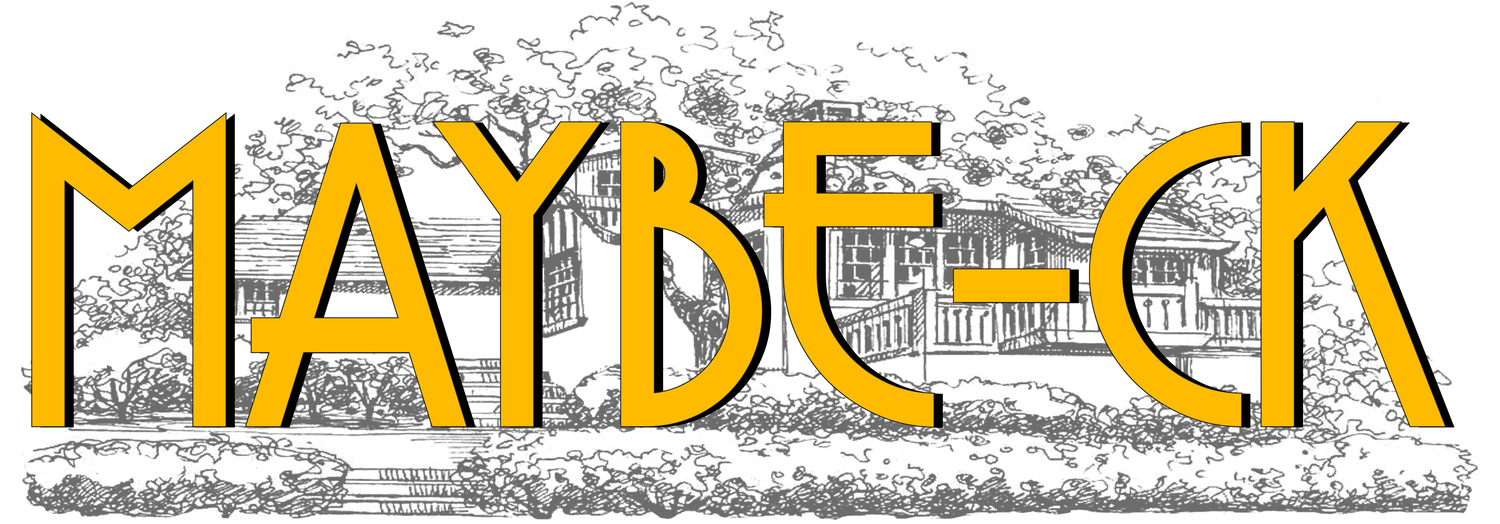Maybeck Feature: Stucco Splatter
I didn't notice at first, but the house has an odd textured stucco splatter. This was a technique that only Maybeck used to my knowledge. It is one of my strongest pieces of evidence since it is so unusual and featured on confirmed Maybecks.
From the Berkeley Architectural Heritage Association:
Daniella Thompson, BAHA 2006. Joralemon House, 1924
Ira B. & Dorothy Joralemon House
168 Southampton Avenue
(Bernard Maybeck, 1924)
"As part of a remodel of Bernard Maybeck’s 1924 masterpiece, the new owners rose to the challenge of restoring the unique, original exterior coating. Maybeck had prescribed “earth color,” a composition intermingling four colors of wet stucco—pale chrome yellow, deep ochre, Venetian red, and gray—to be spattered on the walls in turn. At Maybeck’s direction, the young Joralemons dipped whisk brooms into the mix and flipped them toward the walls, which scattered the colored stucco, creating what Maybeck called “vibrant colors.”
"About 15 years ago, because of cracking in the original finish, the exterior was covered with a layer of commercially sprayed stucco. Hidden behind a planter pot by the front entrance, the new owners found a patch of the original finish and color, and sought to recreate the look and technique, but more efficiently executed with sprayed paint.
"Faced with this intriguing challenge, their painting contractor enlisted the aid of a decorative painter known for her faux finishes. With air compressor, sheetrock hopper guns, and hoses, 100 gallons of paint were flung at the thousands of square feet of wall. After trial and error, the technique was refined and mastered, including brushes and sponges in the capable hands of the faux finisher. The result was a spectacular success, replicating the original look and returning Maybeck’s touch to the exterior of this very striking house."
-Berkeley Architectural Heritage Association
http://berkeleyheritage.com/awards/awards2006.2.html
In the front of the house it looks like black speckle. I breezed by assuming it was mildew or something.
In protected areas, like under the kitchen balcony, it appears more pronounced.
This small area off the laundry has some added colors:
Seen here is the black that's all over and a couple colors you can't see anywhere else - a buttermilk color and a terracotta red. It's hard to tell what was the intended effect of having more colors there. Best guess would be to blend with colors in the landscaping.
I even see the splatter on the original electrical permit which was in a box on the side of the house near the crawl space door! The first two sets of permits were under here. Looks like the electrical permit was near a gap in the door that covers the meter box.
Maybeck also used this type of splatter on the Oakland Packard dealership though this building is no longer around.
"The dull surfaces of plastered walls never appealed to [Maybeck] and when he used stucco for reasons of economy he always attempted to enrich is by some means. The Jockers house (1911) had rough cast and contrasting troweled surfaces; the Kennedy studio used variously colored plasters without restraint. Most late houses, like the McMurray and the Staniford, had stucco exteriors modeled in several colors of plaster applied in successive dash coats. This method... produced a lively finish. But the hand-controlled application was not economical for use on large structures. A new technique, which covered concrete surfaces with a coat of plaster blown by air guns, took quantities of cement, pigment, and water, and mixed them as they were driven against the surface of the building. Maybeck saw that with this method he could vary the pigmentation of the plaster almost at will. He did so on the Oakland [Packard Dealership] building, first stationing himself across nearby Lake Merritt where he conducted the finishing operations by field telephone." Kenneth Cardwell from Bernard Maybeck / Arisan, Architect, Artist.
To sum up - the colorful stucco splatter is a distinctly Maybeck feature like the Venturi chimney. From what I can tell, the specific whisk broom splatter was done only in the '20s and only to dress up flat stucco exteriors (Maybe 3/4 or more of his projects from the -period were stucco). The Wallen #1 (1932) and J.B. Tufts #3 (1931) of the early '30s are simply plain stucco it appears.
I was lucky enough to see the 1921 Calkins house, and it seems like it is one of the few left with this finish that has not been painted.
The streak is from a gutter that was in disrepair.





